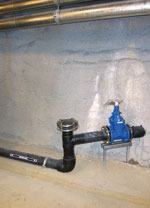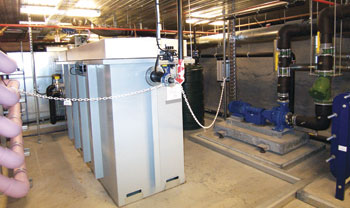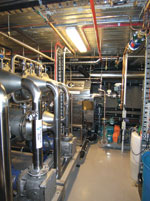Architecture, Hot and Cold
The chief benefit of PCMs is that they have a significantly higher freezing temperature (around 60 degrees F) than other substances, which means water returning in the loop system via evaporative cooling towers needs to be cooled less than usual. Although HVAC systems using PCMs have been installed in the U.S., they are relatively uncommon anywhere. At CH2, the 30,000 PCMs−they look like baseballs−divided among the basement's three tanks can be used 80 percent of the year. Otherwise, the chilled beams rely on the rooftop chiller and cooling towers during peak loading conditions in summertime, which is typically the last 2 hours of the work day. The architects supplemented the cooling towers with so-called "shower towers," which act like public art anchored to the south elevation. The towers are 40-foot-high, 5-foot-diameter vertical shafts of ETFE material with a shower head installed at the top and a glass catchment basin at the bottom. The towers provide chilled water to the mechanical system (cooling it nearly 10 degrees F), while also cooling the air for ground-floor retail spaces. Wall says the towers cool water much more efficiently than the CFD analysis originally indicated. At night they glow like five tubes along the column lines, while water cascades across the glass basins. Pearce likes the way the towers add to the building's dynamism−the moving wood panels on the west side, the spinning rooftop turbines, and the sway of the plants on the north side−all sustainable signposts meant to engage the city's residents.
|
||||
The description of CH2's mechanical system can make it sound easy to accomplish, but many nuanced considerations and details are required to make it work. For one, Wall says they had to install chilled beams at windows to cut the heat load from sunlight but were able to incorporate the beams into light shelves that could be used to control daylighting. A common concern regarding chilled beams and ceilings is condensation, a topic that raises Wall's ire. "As an engineer, I find this topic hugely annoying because we only have to maintain indoor humidity between 40 and 60 percent," he says. "In a museum, you need 45 to 50 percent humidity, so anyone saying you can't do a chilled beam in this city is saying you can't design a museum." Since CH2 isn't naturally ventilated, the facade was designed to be relatively airtight, helping to prevent condensation problems (the HVAC system also offsets high humidity when the windows open for night purging). All of this is monitored with the building management system through 2,500 probes and control points located throughout the structure. So far, the mechanical system hasn't had major problems.
By far, the most challenging aspect of the building's systems has been the unusual sewer-mining plant in the basement. This system draws nearly 12,000 gallons of raw sewage per day from the city's drains, filters out the physical waste, and then treats the water through a series of high-tech components. Coupled with a rainwater collection system, the mining plant supplies all of CH2's nonpotable water requirements, including the HVAC system. Eventually, it's hoped that the plant will feed nonpotable water back to the city for fountains and irrigation, as the system is designed to handle 26,000 gallons per day. "This system uses one-third the energy of a desalinization plant," Pearce says, in sly reference to political plans afoot for such a plant in the Melbourne area, a region long-plagued by drought.
From Energy to Occupancy
The designers and the client for CH2 all stress that while energy and water savings are worthy goals, the comfort of the occupants is the ultimate reason for the environmental strategies deployed in the building. Pearce says a hallmark of the Australian attitude toward sustainable design in offices is equity−thus, an occupant on the top floor would have a similar environmental quality as one on a lower floor. At CH2, windows narrow toward the upper floors and widen toward the lower, so intense daylight at the higher offices will appear similar to lower floors. To ensure equity, DesignInc and the city are working with the London-based postoccupancy expert Adrian Leaman, with the Usable Buildings Trust, on statistically gauging occupant satisfaction with the work environment in the next several years.
John Williams, a director in DesignInc's Melbourne office, says the city has invested so much into CH2 in hopes that it could influence the development of subsequent buildings, including housing, that involves city government. The city projected a 4.9 percent increase in effectiveness for the staff of 540 employed in the building, which translates into nearly $1 million in annual savings. Seeing those goals through was always Pearce's aim. He says he "likes to come to a place, build a building, and stay there afterward to make sure it works." He adds, "That's the only way you can find out about your own profession."












